Hangyeol Yu
HyperCLOVA X Technical Report
Apr 13, 2024Abstract:We introduce HyperCLOVA X, a family of large language models (LLMs) tailored to the Korean language and culture, along with competitive capabilities in English, math, and coding. HyperCLOVA X was trained on a balanced mix of Korean, English, and code data, followed by instruction-tuning with high-quality human-annotated datasets while abiding by strict safety guidelines reflecting our commitment to responsible AI. The model is evaluated across various benchmarks, including comprehensive reasoning, knowledge, commonsense, factuality, coding, math, chatting, instruction-following, and harmlessness, in both Korean and English. HyperCLOVA X exhibits strong reasoning capabilities in Korean backed by a deep understanding of the language and cultural nuances. Further analysis of the inherent bilingual nature and its extension to multilingualism highlights the model's cross-lingual proficiency and strong generalization ability to untargeted languages, including machine translation between several language pairs and cross-lingual inference tasks. We believe that HyperCLOVA X can provide helpful guidance for regions or countries in developing their sovereign LLMs.
Towards Zero-Shot Functional Compositionality of Language Models
Mar 06, 2023Abstract:Large Pre-trained Language Models (PLM) have become the most desirable starting point in the field of NLP, as they have become remarkably good at solving many individual tasks. Despite such success, in this paper, we argue that current paradigms of working with PLMs are neglecting a critical aspect of modeling human intelligence: functional compositionality. Functional compositionality - the ability to compose learned tasks - has been a long-standing challenge in the field of AI (and many other fields) as it is considered one of the hallmarks of human intelligence. An illustrative example of such is cross-lingual summarization, where a bilingual person (English-French) could directly summarize an English document into French sentences without having to translate the English document or summary into French explicitly. We discuss why this matter is an important open problem that requires further attention from the field. Then, we show that current PLMs (e.g., GPT-2 and T5) don't have functional compositionality yet and it is far from human-level generalizability. Finally, we suggest several research directions that could push the field towards zero-shot functional compositionality of language models.
Evaluating the Knowledge Dependency of Questions
Nov 21, 2022Abstract:The automatic generation of Multiple Choice Questions (MCQ) has the potential to reduce the time educators spend on student assessment significantly. However, existing evaluation metrics for MCQ generation, such as BLEU, ROUGE, and METEOR, focus on the n-gram based similarity of the generated MCQ to the gold sample in the dataset and disregard their educational value. They fail to evaluate the MCQ's ability to assess the student's knowledge of the corresponding target fact. To tackle this issue, we propose a novel automatic evaluation metric, coined Knowledge Dependent Answerability (KDA), which measures the MCQ's answerability given knowledge of the target fact. Specifically, we first show how to measure KDA based on student responses from a human survey. Then, we propose two automatic evaluation metrics, KDA_disc and KDA_cont, that approximate KDA by leveraging pre-trained language models to imitate students' problem-solving behavior. Through our human studies, we show that KDA_disc and KDA_soft have strong correlations with both (1) KDA and (2) usability in an actual classroom setting, labeled by experts. Furthermore, when combined with n-gram based similarity metrics, KDA_disc and KDA_cont are shown to have a strong predictive power for various expert-labeled MCQ quality measures.
Dialogue Summaries as Dialogue States (DS2), Template-Guided Summarization for Few-shot Dialogue State Tracking
Mar 03, 2022
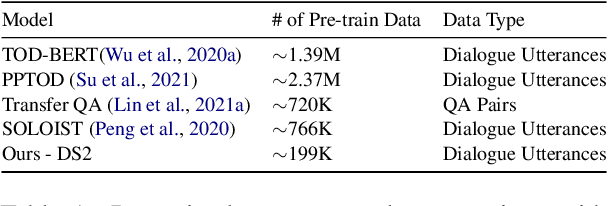
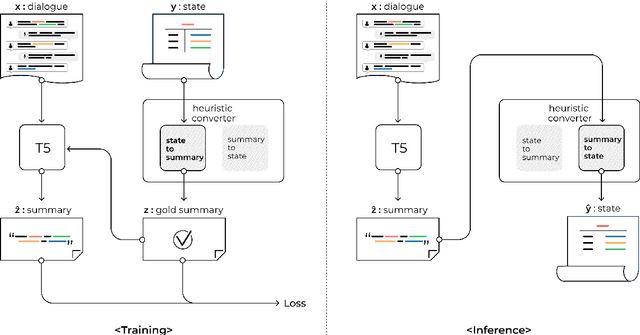
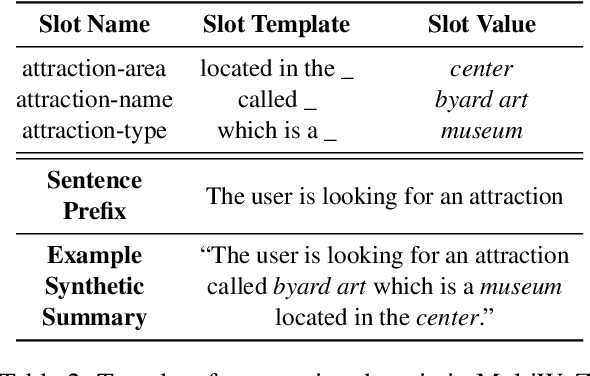
Abstract:Annotating task-oriented dialogues is notorious for the expensive and difficult data collection process. Few-shot dialogue state tracking (DST) is a realistic solution to this problem. In this paper, we hypothesize that dialogue summaries are essentially unstructured dialogue states; hence, we propose to reformulate dialogue state tracking as a dialogue summarization problem. To elaborate, we train a text-to-text language model with synthetic template-based dialogue summaries, generated by a set of rules from the dialogue states. Then, the dialogue states can be recovered by inversely applying the summary generation rules. We empirically show that our method DS2 outperforms previous works on few-shot DST in MultiWoZ 2.0 and 2.1, in both cross-domain and multi-domain settings. Our method also exhibits vast speedup during both training and inference as it can generate all states at once. Finally, based on our analysis, we discover that the naturalness of the summary templates plays a key role for successful training.
Knowledge Transfer by Discriminative Pre-training for Academic Performance Prediction
Jul 12, 2021



Abstract:The needs for precisely estimating a student's academic performance have been emphasized with an increasing amount of attention paid to Intelligent Tutoring System (ITS). However, since labels for academic performance, such as test scores, are collected from outside of ITS, obtaining the labels is costly, leading to label-scarcity problem which brings challenge in taking machine learning approaches for academic performance prediction. To this end, inspired by the recent advancement of pre-training method in natural language processing community, we propose DPA, a transfer learning framework with Discriminative Pre-training tasks for Academic performance prediction. DPA pre-trains two models, a generator and a discriminator, and fine-tunes the discriminator on academic performance prediction. In DPA's pre-training phase, a sequence of interactions where some tokens are masked is provided to the generator which is trained to reconstruct the original sequence. Then, the discriminator takes an interaction sequence where the masked tokens are replaced by the generator's outputs, and is trained to predict the originalities of all tokens in the sequence. Compared to the previous state-of-the-art generative pre-training method, DPA is more sample efficient, leading to fast convergence to lower academic performance prediction error. We conduct extensive experimental studies on a real-world dataset obtained from a multi-platform ITS application and show that DPA outperforms the previous state-of-the-art generative pre-training method with a reduction of 4.05% in mean absolute error and more robust to increased label-scarcity.
SAINT+: Integrating Temporal Features for EdNet Correctness Prediction
Oct 19, 2020
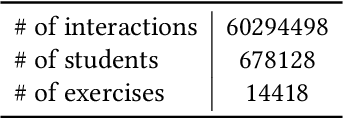
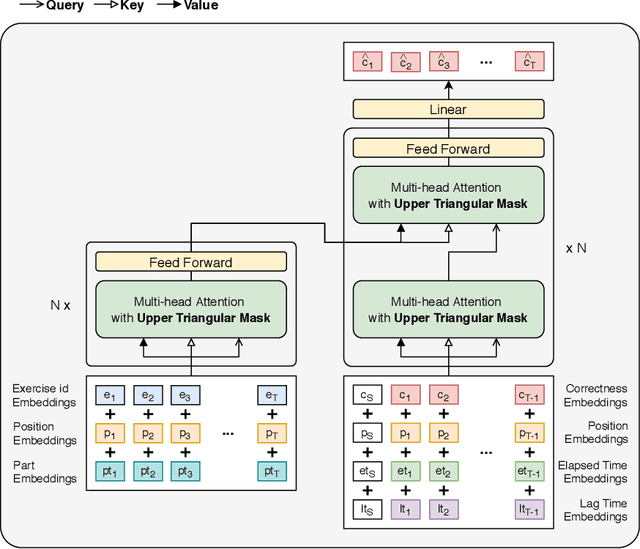
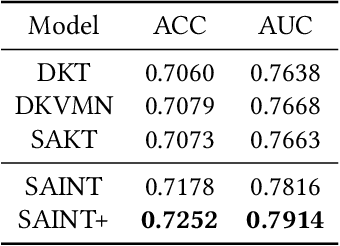
Abstract:We propose SAINT+, a successor of SAINT which is a Transformer based knowledge tracing model that separately processes exercise information and student response information. Following the architecture of SAINT, SAINT+ has an encoder-decoder structure where the encoder applies self-attention layers to a stream of exercise embeddings, and the decoder alternately applies self-attention layers and encoder-decoder attention layers to streams of response embeddings and encoder output. Moreover, SAINT+ incorporates two temporal feature embeddings into the response embeddings: elapsed time, the time taken for a student to answer, and lag time, the time interval between adjacent learning activities. We empirically evaluate the effectiveness of SAINT+ on EdNet, the largest publicly available benchmark dataset in the education domain. Experimental results show that SAINT+ achieves state-of-the-art performance in knowledge tracing with an improvement of 1.25% in area under receiver operating characteristic curve compared to SAINT, the current state-of-the-art model in EdNet dataset.
On Correctness of Automatic Differentiation for Non-Differentiable Functions
Jun 12, 2020
Abstract:Differentiation lies at the core of many machine-learning algorithms, and is well-supported by popular autodiff systems, such as TensorFlow and PyTorch. Originally, these systems have been developed to compute derivatives of differentiable functions, but in practice, they are commonly applied to functions with non-differentiabilities. For instance, neural networks using ReLU define non-differentiable functions in general, but the gradients of losses involving those functions are computed using autodiff systems in practice. This status quo raises a natural question: are autodiff systems correct in any formal sense when they are applied to such non-differentiable functions? In this paper, we provide a positive answer to this question. Using counterexamples, we first point out flaws in often-used informal arguments, such as: non-differentiabilities arising in deep learning do not cause any issues because they form a measure-zero set. We then investigate a class of functions, called PAP functions, that includes nearly all (possibly non-differentiable) functions in deep learning nowadays. For these PAP functions, we propose a new type of derivatives, called intensional derivatives, and prove that these derivatives always exist and coincide with standard derivatives for almost all inputs. We also show that these intensional derivatives are what most autodiff systems compute or try to compute essentially. In this way, we formally establish the correctness of autodiff systems applied to non-differentiable functions.
Towards Verified Stochastic Variational Inference for Probabilistic Programs
Jul 25, 2019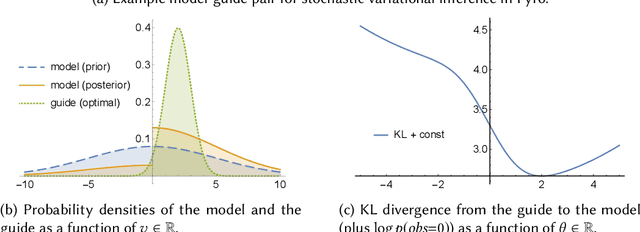

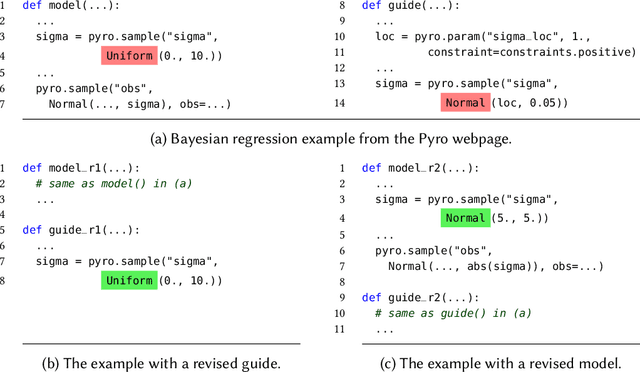
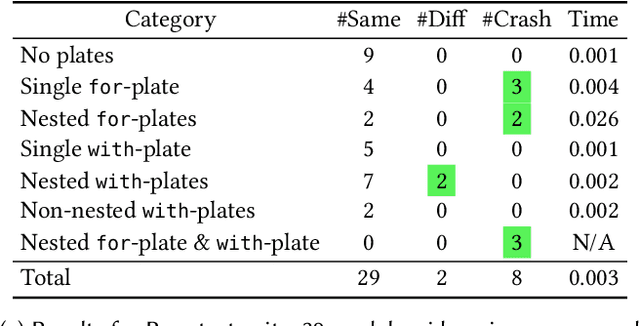
Abstract:Probabilistic programming is the idea of writing models from statistics and machine learning using program notations and reasoning about these models using generic inference engines. Recently its combination with deep learning has been explored intensely, which led to the development of deep probabilistic programming languages. At the core of this development lie inference engines based on stochastic variational inference algorithms. When asked to find information about the posterior distribution of a model written in such a language, these algorithms convert this posterior-inference query into an optimisation problem and solve it approximately by a form of gradient ascent or descent. In this paper, we analyse one of the most fundamental and versatile variational inference algorithms, called score estimator or REINFORCE, using tools from denotational semantics and program analysis. We formally express what this algorithm does on models denoted by programs, and expose implicit assumptions made by the algorithm on the models. The violation of these assumptions may lead to an undefined optimisation objective or the loss of convergence guarantee of the optimisation process. We then describe rules for proving these assumptions, which can be automated by static program analyses. Some of our rules use nontrivial facts from continuous mathematics, and let us replace requirements about integrals in the assumptions, by conditions involving differentiation or boundedness, which are much easier to prove automatically. Following our general methodology, we have developed a static program analysis for the Pyro programming language that aims at discharging the assumption about what we call model-guide support match. Applied to the eight representative model-guide pairs from the Pyro webpage, our analysis finds a bug in two of these cases and shows that the assumptions are met in the others.
Reparameterization Gradient for Non-differentiable Models
Oct 25, 2018


Abstract:We present a new algorithm for stochastic variational inference that targets at models with non-differentiable densities. One of the key challenges in stochastic variational inference is to come up with a low-variance estimator of the gradient of a variational objective. We tackle the challenge by generalizing the reparameterization trick, one of the most effective techniques for addressing the variance issue for differentiable models, so that the trick works for non-differentiable models as well. Our algorithm splits the space of latent variables into regions where the density of the variables is differentiable, and their boundaries where the density may fail to be differentiable. For each differentiable region, the algorithm applies the standard reparameterization trick and estimates the gradient restricted to the region. For each potentially non-differentiable boundary, it uses a form of manifold sampling and computes the direction for variational parameters that, if followed, would increase the boundary's contribution to the variational objective. The sum of all the estimates becomes the gradient estimate of our algorithm. Our estimator enjoys the reduced variance of the reparameterization gradient while remaining unbiased even for non-differentiable models. The experiments with our preliminary implementation confirm the benefit of reduced variance and unbiasedness.
 Add to Chrome
Add to Chrome Add to Firefox
Add to Firefox Add to Edge
Add to Edge